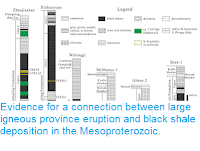The first animals appeared and radiated over the Neoproterozoic-early Palaeozoic transition, between about 800 and 500 million years ago. This is thought to have been a time of extreme climatic and atmospheric variability, with at least two significant ice ages during the Cryogenian Period (between about 720 and 635 million years ago), and fluctuations in atmospheric (and therefore also marine) oxygen levels across the entire time interval. The first complex ecosystems appear towards the end of the Ediacaran Period (about 635 to 541 million years ago), in a series of ecosystems known collectively as the Ediacaran Fauna. The first of these was for a long time thought to be the White Sea Fauna, a collection of simple frond-like organisms that appeared in shallow, high latitude waters, where the cold temperatures were thought to have led to higher levels of dissolved oxygen in the water, allowing for the development of more complex organisms. However, it is now understood that the deep-water Avalon Fauna, predates the White Sea Fauna. This is puzzling for several reasons. Firstly, the Avalon Fauna is clearly more complex than the White Sea Fauna, with a greater variety of organisms, including two uniquely Ediacaran groups, the Arboreomorpha and Rangeomorpha, as well as organisms interpreted as early Cnidarians and Sponges. Secondly, in all later periods the shallow seas have been the centre of evolutionary radiations, with the deep seas often providing refuges for members of older groups. Thirdly, and most confusingly, the sea has a lower dissolved oxygen level at greater depths, since the atmosphere contains more oxygen than the oceans, and oxygen in the seas is dependent on absorption of oxygen from the atmosphere.
In a paper published in the journal Proceedings of the Royal Society Series B on 12 December 2018, Thomas Boag and Richard Stockey of the Department of Geological Sciences at Stanford University, Leanne Elder of the Department of Geology and Geophysics at Yale University and the Museum of Natural History at the University of Colorado Boulder, Pincelli Hull, also of the Department of Geology and Geophysics at Yale University and Erik Sperling, also of the Department of Geological Sciences at Stanford University, present a theoretical explanation for this mystery.
Boag et al. reason that, while cold seawater will retain more oxygen than warm seawater, this would have been less of an advantage during the Ediacaran, when atmospheric oxygen levels are thought to have fluctuated considerably, than it is today, when oxygen levels in the atmosphere remain constant. This is because, while cold water can retain more oxygen than warm water, oxygen diffuses through warm water much more quickly than it does through cold water. This would mean that, should the level of atmospheric oxygen drop sharply for some reason and then recover, it would take cold surface waters longer to regain their dissolved oxygen than warm surface waters, potentially making this environment just as hostile to early animals.
Deeper waters at all latitudes remain permanently cold, enabling them to retain a higher amount of oxygen, and are insulated from the atmosphere by the waters above. This would mean that, even if the oxygen levels in deepwater Ediacaran environments were not very high, they would at least be likely to remain constant, creating a more stable environment for the first animals.
Under this scenario, the first complex ecosystems would have developed in the cold, dark, but stable waters of the outer shelf about 571 million years ago, with some of these organisms venturing into the less hospitable cold shallow waters at high latitudes from about 560 million years ago, to form the more simple White Sea Fauna, then finally the more diverse shallow-water Nama Fauna appearing after about 550 million years ago, almost certainly coinciding with the development of a more stable atmosphere.
See also...
Boag et al. reason that, while cold seawater will retain more oxygen than warm seawater, this would have been less of an advantage during the Ediacaran, when atmospheric oxygen levels are thought to have fluctuated considerably, than it is today, when oxygen levels in the atmosphere remain constant. This is because, while cold water can retain more oxygen than warm water, oxygen diffuses through warm water much more quickly than it does through cold water. This would mean that, should the level of atmospheric oxygen drop sharply for some reason and then recover, it would take cold surface waters longer to regain their dissolved oxygen than warm surface waters, potentially making this environment just as hostile to early animals.
Representative Avalon Fauna taxa from the Ediacaran rocks of the Bonavista Peninsula (A)–(D), (F), (H)–(I), and the Spaniard’s Bay region (E), (G), (J), Newfoundland. (A) Aspidella terranovica, Fermeuse Formation. (B) Hiemalora stellaris, Murphy’s Cove, Mistaken Point Formation. (C) Parviscopa bonavistensis, Mistaken Point Formation. (D) Charniodiscus sp. Mistaken Point Formation. (E) Beothukis mistakensis, Trepassey Formation. (F) Primocandelabrum hiemaloranum, Mistaken Point Formation. (G) Avalofractus abaculus, Trepassey Formation. (H) Fractofusus andersoni, Trepassey Formation. (I) Hadryniscala avalonica, Mistaken Point Formation. (J) Trepassia wardae, Trepassey Formation. Scale bars are 10 mm, except (F), (H) and (I), which are 50 mm. Liu & Conliffe (2015).
Deeper waters at all latitudes remain permanently cold, enabling them to retain a higher amount of oxygen, and are insulated from the atmosphere by the waters above. This would mean that, even if the oxygen levels in deepwater Ediacaran environments were not very high, they would at least be likely to remain constant, creating a more stable environment for the first animals.
Under this scenario, the first complex ecosystems would have developed in the cold, dark, but stable waters of the outer shelf about 571 million years ago, with some of these organisms venturing into the less hospitable cold shallow waters at high latitudes from about 560 million years ago, to form the more simple White Sea Fauna, then finally the more diverse shallow-water Nama Fauna appearing after about 550 million years ago, almost certainly coinciding with the development of a more stable atmosphere.
See also...
Follow Sciency Thoughts on
Facebook.







